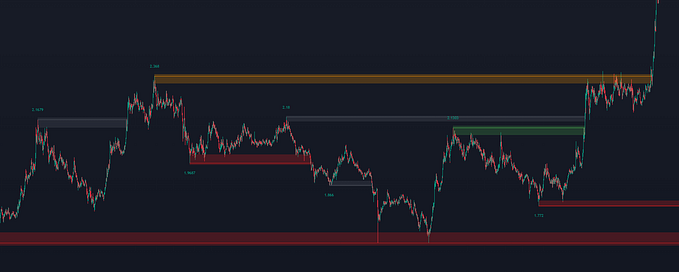
Disclosure: I work at Ripple, a member of the Open Payments Coalition and contributor to the open source PayID technology
Two weeks ago, I wrote about how payments needed an email address to allow for interoperability between networks and readability for senders and receivers.
I laid out how I think PayID is the solution to solve those problems and, finally, bring money to the Internet.
Afterwards, I got amazing feedback from my friends, family, and other readers about the post — it was a great opportunity to engage in detailed discussion about the future of money and innovations in payments.
With that said, I also heard the feedback that my post painted a great vision for PayID, but failed to tactically show people how to get a PayID and get involved in the movement of opening payments up.
This week, I put together a short article and how to get a PayID from a list of supported apps, or even create your own PayID!
Let me know when you set one up 😊
I have two PayIDs: jim$payme.plus (on a supported app) and jim$moneyjim.tk (my own PayID server).
Get a PayID from a Supporting App
PayID is supported in an array of apps, with more to come.
PayID was created and is maintained by the Open Payments Coalition, a group of 40+ fintech companies, crypto stalwarts, and non-profit organizations who have come together to accelerate the vision for open payments.
“Just like the creation and widespread adoption of the internet and mobile phones, PayID drives payments forward, simplifying global payments for all and bringing us one step closer to a world where money moves as easily as information.” — Open Payments Coalition
Each one of these companies have pledged to offer PayID to their customers.
PayMe+
PayMe+ is a collaboration between two members of the Open Payments Coalition: CoinField and Towo Labs.
It’s the simplest way to get a PayID.
You download the app, create a profile that’s connected to a PayID (example$payme.plus), and then easily connect your crypto and payment networks.
I got my PayID set up in less than 5 minutes with PayMe+.
Check out PayMe+ here.
See below for the demo:
However, it’s worth noting that PayMe+ isn’t a wallet. So you can get a PayID with PayMe+, but you won’t be able to send money to other PayIDs.
If you want to pay with PayID, you’re going to want to get a wallet like the ones listed below.
Tangem
Tangem is a hardware wallet in the form of a credit card that can send, store, and receive digital assets.
With a Tangem card, you can create a PayID, as well as send and receive money with it.

You can get a PayID with Tangem by buying their card and downloading their Tangem mobile app.
See Tangem in action below:

Bitrue
Bitrue is a an XRP-centric crypto exchange, offering more than 75 trading pairs with XRP — as well as XRP-backed financial products like interest accrual (called staking in the crypto world) and XRP-collateralized loans.
Like Tangem, Bitrue offers a full-featured PayID solution, with PayID creation, send, and receive capabilities.
“PayID is one of the biggest leaps forward for crypto currency adoption that we’ve ever seen. The ability for users to share their addresses through a pronounceable and memorable format will help demystify the payment process for millions..” — Curis Wang, CEO of Bitrue
Sign up at Bitrue today and get a PayID with your account
Crypto.com
Crypto.com is a self-described crypto bank, starting off with a wallet product and expanding to other financial products like borrowing, lending, staking, and exchange capabilities.
PayID support will be live on November 2nd, 2020 with a number of supported cryptocurrencies that include CRO, ETH, BTC, XRP and ERC20 tokens.
Download the Crypto.com wallet today to get a PayID.
CoinField
CoinField is cryptocurrency exchange that is available in 190+ countries and offers a wide swath of crypto trading pairs.
The unique thing about CoinField is that it automatically assigns a PayID to you when you create an account on its platform — as opposed to manual creation of a PayID.
Sign up at Coinfield to get a PayID.

Do It Yourself
All these companies are running PayID servers in order to give their customers PayIDs.
A PayID server is a simple server that forms a database of customers and their respective PayIDs, as well as responds to other apps that ask for information on customers’ PayIDs (e.g., if an app wants to send money to a customer’s PayID, the server would receive those requests and relay back relevant information).
Since PayID is free-to-use and open source, anyone can run a PayID server.
You can deploy a PayID server with just a few commands with existing web infrastructure, and then integrate it into an application or account system in just a few lines of code.
Play with the PayID Sandbox if you want to familiarize yourself with the PayID APIs and database in a sandbox environment.
Get a test PayID on your local server
You can set up a PayID server locally in minutes, in order to test out the capabilities of PayID.
Follow the developer documentation, if you’d like to learn how to set up a PayID server locally (i.e., it’ll only be a “test” PayID, and no actual money will flow through it) and create your own PayIDs.
A live PayID using AWS Lambda
You can also super easily set up a live PayID server and send real money to and from your PayIDs, using a cloud computing product called Lambda by Amazon Web Services.
Follow the docs on setting up a PayID server with AWS Lambda.
It took me less than 10 minutes to create live PayIDs (e.g., jim$moneyjim.tk), using a domain name that I owned (moneyjim.tk, which is a free domain that the docs helped me acquire!).
More to come
Like I mentioned, the Open Payments Coalition has 40+ members who are hard at work at offering PayIDs to their customers.
Here are some exciting integrations in the pipeline:
Xumm
Xumm (pronounced ‘sum’) is an XRP wallet that currently supports the “send with PayID” feature, meaning that you can use Xumm to pay money to other PayIDs.
The team is hard at work at getting the “receive with PayID” feature live for their users!

BRD
BRD is a leading cryptocurrency wallet with over 3 million users.
Like Xumm, the app currently supports “send with PayID” with “receive” coming in the near future.
Check out BRD’s PayID demo:

Bitpay
Bitpay is a leading cryptocurrency payment processor for merchants.
They’re a member of the Open Payments Coalition and have put together a demo for the value that PayID can unlock in commerce flows.
See the demo here:
Donations
You can currently donate to the The Water Project, a charity providing access to clean water for communities in developing nations.
More charitable organizations will offer donations with PayID in the near future.










